







































Patrick Knou
Ohio Soybean Association President Shelby County soybean farmer
For farmers, it’s no secret that fall is one of our busiest times of year. Long days away from loved ones are tough, but the feeling you get when you nally nish your last eld is the best. While we are working hard to bring in the harvest, our Ohio Soybean Association (OSA) and Ohio Soybean Council (OSC) organizations are working hard to ensure that the beans we bring in will have places to go.
Two of OSA’s recent wins include the USDA double crop insurance expansion, which covers virtually all Ohio counties. OSA met with the Risk Management Agency in June to provide feedback on what this expansion would mean for farmers. In another win for OSA, a new law has gone into e ect that requires a landlord who wants to terminate a lease to provide written notice of termination before September 1. Both of these changes will allow farmers to make informed decisions about their operations and farm more freely.
I want to remind you that these strides are in large part thanks to our members. From farmers to researchers to agribusiness leaders, your membership helps us continue this policy work on behalf of the soybean industry across the Buckeye State. If you are looking to join us for the rst time or renew your membership, September is the perfect time to do so. We will be running a promotion at Farm Science Review (September 20–22) where you can save $20 on a new or renewed membership. Be sure to visit us at Booth 441 at the corner of Friday Ave. and Tractor St. to take advantage of this great o er and learn more about the work we do for Ohio’s farmers.
Finally, I want to highlight a leadership program that is open to all Ohio farmers who are 21 or older. e American Soybean Association’s (ASA) Corteva Young Leader Program enhances participants’ skills through leadership, communications, and issues-based training, while also building a strong peer network to generate increased success in participants’ businesses and communities. anks to the generous support of ASA and Corteva, the program is free of costs to all participants. e program spans two phases, which will take place at the Corteva Global Business Center in Iowa and at Commodity Classic in Orlando. e skills that are required to farm are the same that are required of good leaders. ose looking to become innovative and engaged growers to serve as the voice of the American farmer should apply before September 30 by visiting www.soyohio.org/YoungLeaderApp
Wishing you all a safe and plentiful harvest!
President
Patrick Knou , Shelby County
Vice President
Rusty Goebel, Williams County
Treasurer
Jerry Bambauer, Auglaize County
Secretary
Trish Cunningham, Union County
Chairman
Ryan Rhoades, Marion County
Trustees
David Clark, Warren County
Justin Esselburn, Holmes County
Austin Heil, Hardin County
Caitlyn Heimerl, Industry A liate Ex-O cio
Je Magyar, Ashtabula County
Je McKanna, Hancock County
Bennett Musselman, Pickaway County
Derek Reusser, Holmes County
Andy Stickel, Wood County
Bob Suver, Clark County
Kerrick Wilson, Preble County
American Soybean Association
Board Representatives
Jerry Bambauer
Scott Metzger
Ryan Rhoades
Sta Credits
Kirk Merritt - Publisher
Julia Brown - Editor
Madi Layman - Sta Writer
Brent Warren - Art Director
Barry Falkner - Photo Quality/Proofer
Ohio Soybean news is published six times a year by the Ohio Soybean Association, 918 Proprietors Rd., Suite A, Worthington, OH 43085. Phone: 614-476-3100. For address corrections contact Ohio Soybean News at 918 Proprietors Rd., Suite A, Worthington, OH 43085.
Web address: www.soyohio.org E-mail: cdeboard@soyohio.org
Comments and statewide news articles should be sent to the above address. Advertising space reservation must be made by the rst of the month preceding publication. In consideration of the acceptance of advertisement, the agency and the advertiser must, in respect of the contents of the advertisement, indemnify and save the publisher harmless against any expense arising from claims or actions against the publisher because of the publication of the content of the advertisement.
For Advertising Sales Contact:
Matt Herman - (612) 812-5833
matt.herman@dtn.com
Patrick Knou




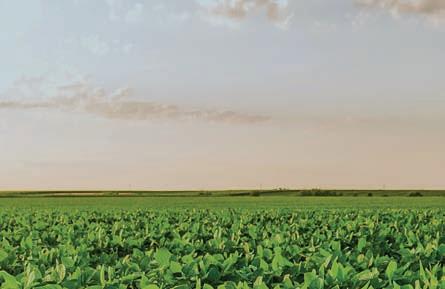







There’s always a better way to do things. Whether it’s a better coffee cup or a better seed like Xitavo™ soybean seed, quality matters. Xitavo soybean is bred tough with triple-stacked Enlist E3®. It includes consistently high performing, high yielding varieties. It brings innovation year over year through our trait pipeline. And it’s backed by BASF’s trusted portfolio and expert on-farm support. Visit xitavosoybeanseed.com or ask your BASF Agronomic Solutions Advisor about a variety best suited for your geography and to get started today. Xitavo Soybean Seed. Seed done right.
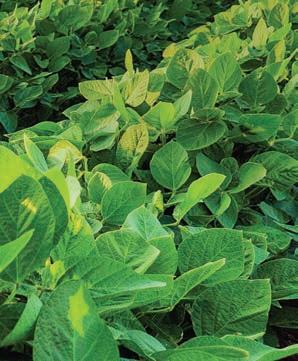



Expand your operation without exposure to future rate hikes with a farm real estate loan from Farm Credit Mid-America. We offer loans that are fully fixed for the long term, with the flexibility to convert* to a lower rate if conditions change. All with guidance from experts in agricultural lending.

Loans subject to credit approval. Additional terms and conditions may apply. Farm Credit Mid-America is an equal opportunity lender. * Conversions subject to eligibility requirements. Fees of $500 may apply. Fee subject to change without notice. There may be additional fees associated with the conversion, such as a wholesale conversion fee.





By Madi Layman
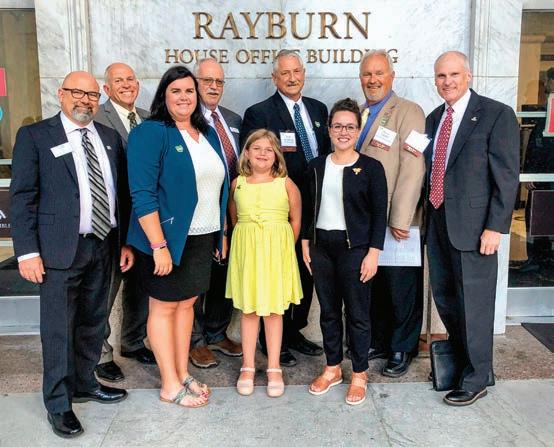
In early July, several Ohio Soybean Association (OSA) board members and staff visited Washington, D.C., to talk with the Ohio Congressional delegation and their staffs about policy priorities for the soybean industry. Topics discussed included the 2023 Farm Bill, biofuels, aquaculture and transportation and infrastructure concerns.
“Our OSA teams spoke with 14 members of Congress and their staffs about a wide variety of topics that affect our day-to-day operations in Ohio,” said OSA President Patrick Knouff of Shelby County. “Getting these in-depth and informative conversations not only benefits your operation now but increases the opportunities available to future generations of soybean farmers.”
Those joining Knouff for the Hill visits included OSA Vice President Rusty Goebel of Williams County, Treasurer Jerry Bambauer of Auglaize County, Secretary Trish Cunningham of Union County, American Soybean Association Executive Committee Member Scott Metzger of Ross County, Bob Suver of Clark County and Kerrick Wilson of Preble County.
“Our advocacy efforts would not be possible without the support of our membership,” Knouff said. “We are able to voice our concerns with representatives and hopefully make a positive impact for the future generations of soybean farmers. Your membership plays a huge role in allowing us to do that.” u
We are dedicated to the eastern Corn Belt. We know your soils, your climate, pests and weeds, and deliver the genetics and traits that perform best for your farm. Seed Consultants. | Simply better.






By Madi Layman
For the first time since 2019, the Ohio State Fair welcomed a full crowd back onto the fairgrounds in late July and early August. With livestock sales shattering previous records and fair attendance reaching over 850,000 people, it is safe to say that many were happy to see the barns filled and sky ride running again.
The Ohio Soybean Council (OSC) had several footprints across the fairgrounds during its twelve-day period. In partnership with the Ohio Farm Bureau Federation, OSC was stationed in the Donahey Agriculture and Horticulture Building with the “Race for Soy” mini pig races. They also hosted a soybean trivia wheel to test attendees’ knowledge about the soybean industry. Additionally, GrowNextGen ambassadors from OSC’s education program taught all ages about DNA, biodiesel and drone technology. Participants would participate in OSC’s fun activities while learning something new about Ohio’s number one industry.
“Our presence in the Agriculture and Horticulture Building does not go unnoticed,” said Mike Heffelfinger, OSC board member and communication/educations committee chair. “Soybeans are such a diverse crop that we can talk about them in terms of animal and human nutrition, as well as their uses in environmentally friendly products. The soybean and agriculture industries offer numerous career opportunities to those in health science, technology or animal agriculture fields. By talking to fairgoers, we can introduce them to the numerous

other livestock and poultry every year. Therefore, OSC supported Ohio State Fair livestock exhibitors with “Swag Bags/Buckets”. Along with a bucket or bag, each livestock exhibitor received a free t-shirt, courtesy of OSC and Farm Credit, an animal stress reliever, an OSC magnet, soybean pins and other fun swag that would be useful on show day.
“The council finds value in supporting the hard work these exhibitors have done preparing for their shows both at the state fair and their county fairs,” Heffelfinger said. “We hope they enjoyed their buckets and had a great time at this year’s fair.”
opportunities the agriculture industry offers.”
On the first Friday of the fair, OSC moved out to the Mountain Dew Midway on the fairgrounds for a soybean day. Fairgoers played the trivia wheel for a chance to win a prize and also entered a “Guess How Many Soybeans” contest. OSC staff and farmers engaged in several conversations around soybean nutrition, on-farm sustainable practices and the various uses of soybeans.
But the fun did not end there. Animal agriculture is the soybean industry’s number one customer; nearly 30 million bushels of Ohio soybeans are fed to pigs, chicken, cattle and
Your soybean checkoff is a proud supporter of the Ohio State Fair and all of its attendees. From educating the general public on the soybean industry to supporting those showing in the ring. OSC hopes everyone filled up on the greasy fair food — possibly fried with soybean oil — and looks forward to seeing you all again next year. u
OSC board members and sta engaged fairgoers with soybean trivia during Soybean Day at the 2022 Ohio State Fair.

Just as online dating apps bring people together, the same concept can be used by soybean farmers to pair the right soybean varieties with the right fields. Production research funded by the soybean checkoff gives farmers the necessary tools to make wise seed selections every year.


Data is increasingly used to aid soybean seed selection. The work begins with breeders using data to evaluate soybean lines that will battle specific diseases and other yield robbers. Data also is incorporated in variety and germplasm exchange between private and public breeding programs to develop new varieties more quickly. Similarly, data garnered via the checkoff’s High Yield + Quality Program provides unbiased yield and seed composition results to guide variety selection that gives farmers and their customers the best soybean value.


Researchers have several checkoff- supported “search” activities underway to identify soybean varieties for specific field situations. These include state-to-state research collaboration through an on-farm network project and creating new technologies to screen varieties for resistance to address such challenges as iron deficiency chlorosis, soybean cyst nematode and Dectes stem borer. Other specialists are searching for opportunities to help farmers grow soybeans in new regions as they adapt to disruptive fluctuations in markets, climate and farm economics.



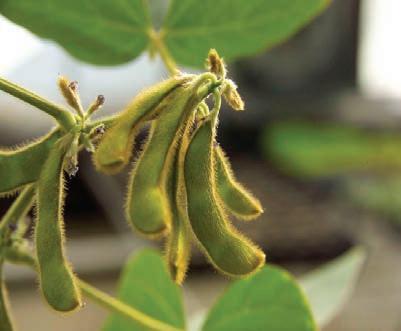
Every field has its own soybean yield-limiting factors; diseases, weeds, nematodes, climate, soil conditions and more. Farmers should review


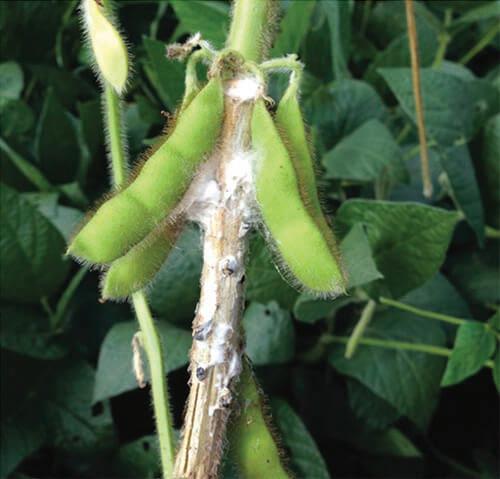
Geographic location dictates which maturity groups work best. One of the ways the soybean checkoff is aiding efforts to get the best varieties into appropriate locations is through on-farm research. Scientists are developing a tool to optimize soybean management practices that will optimize profitability at the field level through efficient input applications. The tool, which will be a combination of models and algorithms, will use self-reported, on-farm production practices and associated costs to identify the management methods that result in best returns.
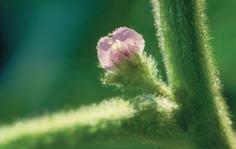




A wide array of soybean checkoff-funded resources is available to farmers to match the right varieties to the right fields. This includes the Soybean Research & Information Network (SRIN soybeanresearchinfo.com), the North Central Soybean Research Program (NCSRP ncsrp.org), United Soybean Board (USB unitedsoybean.org) and state checkoff programs.



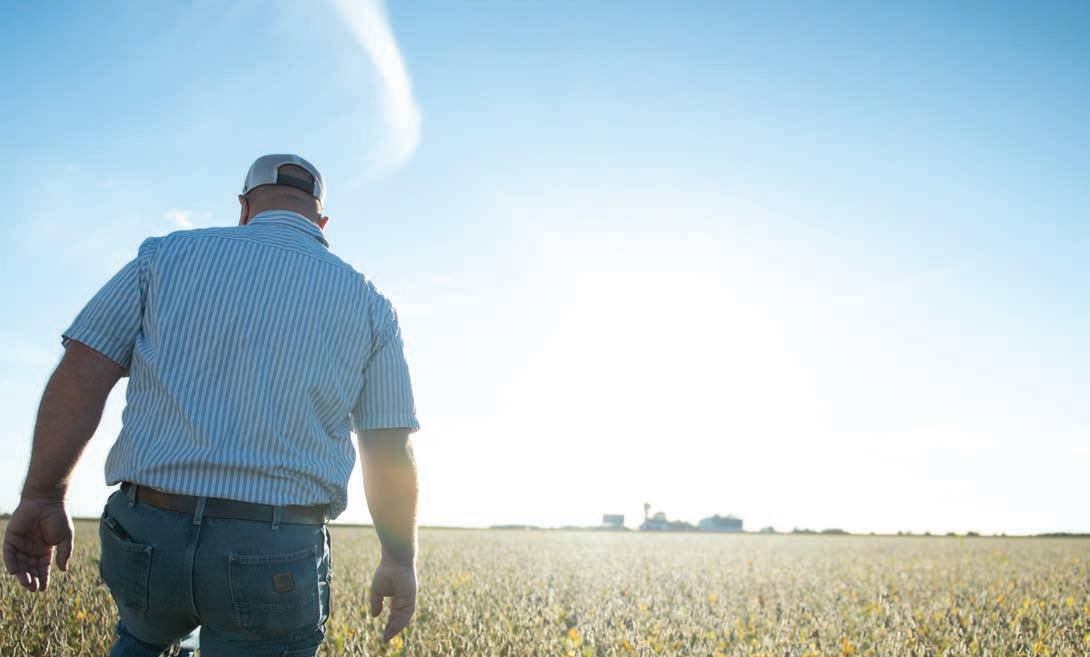
The Field Leader program from the Ohio Soybean Council and the soybean checko keeps you informed about the latest technologies, trends and research in the field, all in an e ort to keep your operation moving forward and to help you become a leader in your field. See how we are keeping you at the forefront of innovation by clicking the “Ohio Field Leader” tab at OCJ.com.




















The next generation of soybean farmers are joining in on the fun. With innovative ideas and an open mind, Tyler Miller joined his family’s farming operation full-time in 2019. Tyler represents District 6 — Crawford, Seneca and Wyandot Counties — on the Ohio Soybean Council Board of Trustees. By collaborating with other Ohio soybean farmers, he is ensuring a profitable future for Ohio’s soybean industry. Learn about Tyler’s experience on his family’s operation and how he is thinking about the future:
Where did you grow up?
I grew up in Crawford County and currently reside in Wyandot County with my wife Kelly, and our 8-monthold son, Brooks.
Where did you go to school? What did you study?
I graduated in 2012 from the University of Toledo, with a BA in Communications concentrated in Public Relations.
When did you decide to come back to work on the farm?
I really didn’t decide I wanted to come back home and farm until my senior year of college. After school I worked at an ag retailer. 2019 was my first season farming full-time.
What counties do you farm in?
We farm in Crawford and Wyandot Counties.
How many acres do you farm? What do you raise?
We operate about 2,000 acres of corn, wheat and soybeans.
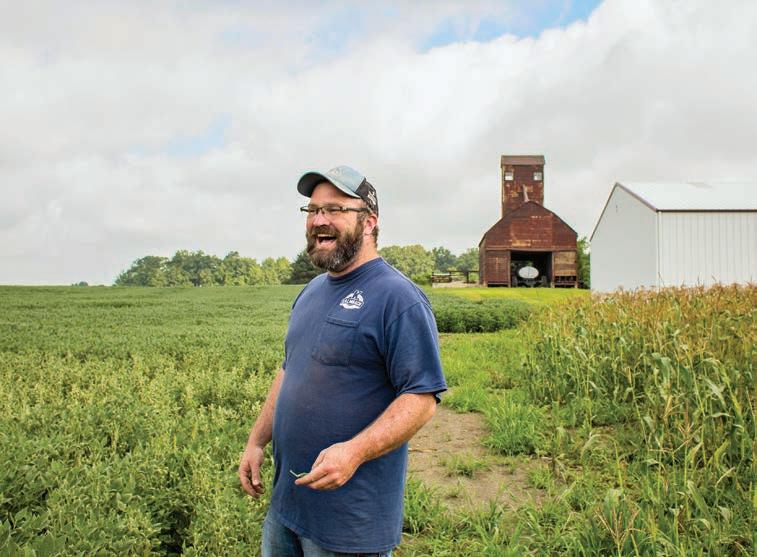
Can you share some of your farm’s history?
Our farm started with my great grandfather. My grandpa and his brother grew the operation and, with the help of my dad and uncle, started one of the first custom application operations in the area. The custom application and retail side has long been gone now, and we are now a full-time row crop operation.
Did you face any challenges when returning to the farm? How did you solve them?
Since farming full time, I have thankfully only had to deal with a widespread prevent-plant spring, COVID-19, supply chain setbacks, vomitoxin-riddled corn, skyrocketing fertilizer prices … there’s always going to be something.
Tyler joined the Ohio Soybean Council Board of Trustees in 2021. He currently serves on the communication/education committee.
Be flexible and don’t be afraid of a plan B, C, D.
What are some important business planning lessons you have learned since working on the farm?
Always be looking for value-added practices. It’s easy to look at a task and look at the capital investment, as well as the manpower and time and be completely overwhelmed and write it off. But look for the hidden benefits as well. Several years ago, we started doing a majority of our own spraying. Not knowing how much time and effort we would put into it, we invested minimally in a compact
pull-type and a side-by-side. Top dressing wheat turned into burndown into running corn. We ended up covering over 4,000 acres that year. Running the numbers, it was easily a 125% or more ROI based just on custom application savings in one growing season. Add in the cash and carry savings on chemicals and the agronomic benefits of application at the ideal timing versus being on someone’s stack of work orders — it's a no brainer to put the effort in.
Do you have a favorite piece of machinery on your farm?
I would have to say one of my favorite operations on the farm is plowing in tile. Everyone running around, operating all the different equipment, calculating all the different grades and layouts, trying not to bury a 40,000-pound tractor … very few things are





Are you seeking ways to improve on farm efficiency? If so, what resources are you using?
One of the ways we are working to improve our on-farm efficiency is with technology. Fifteen years ago, everyone thought it couldn’t get better than automated guidance systems. Today we’re working on implementing several different systems. Application controllers, variable rate technology and precision seed meters are just some to name. As much of a pain they can be to manage some days, I somehow doubt we could afford to go without them. With the precision it brings to application quality and planting consistency, it’s an easy value to see, but hard to put a number on unless it’s gone.
What practices are you doing today that will prepare your farm for the








operation done in-house as possible. It’s impossible to do it all but having a hand in what’s possible to control goes ten-fold in quality, cost and efficiency for the operation.
What piece of advice do you have for young farmers?
That’s a tricky one … I like to think of myself as a young farmer, but soak up all the advice you can. Everyone’s has a different theory on how to do something and a different way of thinking about it. Not saying they’re all correct but looking at something from a different point of view can go quite a ways.
What do you do for fun outside of farming?
Well, that’s changed quite a bit as of late. Now, most of my free time is spent rolling around on the living room floor with my son playing with loud colorful toys, it’s a great time.



























High crop prices and COVIDera legislative ad-hoc government payments coupled with lower interest rates (among other factors) over the last two and half years have given strength to farmland markets. Higher input costs over the last year and half with rising interest rates have offset some of this strength but farmland values continue to increase. Many of these same factors have given strength to the farmland rental markets which have also seen increases this last year and will likely see additional increases in 2022.
According to the Western Ohio Cropland Values and Cash Rents Survey, cropland values in western Ohio are expected to increase in 2022 by 8.0 to 11.3 percent depending on the region and land class. This is on top of increases from 2020 to 2021 of 7.2 to 26.6 percent depending on region and productivity class.
Cash rents are expected to increase from 5.8 to 6.8 percent depending on the region and land class. This is on top of rental increases of 1.5 to 7.7 percent from 2020 to 2021.

Ohio Cropland Values and Cash Rent
Ohio cropland varies significantly in its production capabilities and, consequently, cropland values and

cash rents vary widely throughout the state. Generally, western Ohio cropland values and cash rents differ from much of southern and eastern Ohio cropland values and cash rents. The primary factors affecting these values and rents are land productivity and potential crop return, and the variability of those crop returns. Soils, fertility and drainage/irrigation capabilities are primary factors that most influence land productivity, crop return and variability of those crop returns.
Other factors impacting land values and cash rents may include field size and shape, field accessibility, market access, local market prices, field perimeter characteristics and potential for wildlife damage, buildings and grain storage, previous tillage system and crops, tolerant/resistant weed populations, USDA Program Yields, population density and competition for the cropland in a region. Factors specific to cash rental rates may include services provided by the operator and specific conditions of the lease.

By Barry Ward, Leader, Production Business Management Director, OSU Income Tax Schools
OSU Extension, Agriculture & Natural Resources
rates. Professionals surveyed were rural appraisers, agricultural lenders, professional farm managers, ag business professionals, OSU Extension educators, farmers, landowners and Farm Service Agency personnel.
Respondents were asked to group their estimates based on three land quality classes: average, top and poor. Within each land-quality class, respondents were asked to estimate average corn and soybean yields for a five-year period based on typical farming practices. Survey respondents were also asked to estimate current bare cropland values and cash rents negotiated in the current or recent year for each land-quality class. Survey results are summarized for western Ohio with regional summaries (subsets of western Ohio) for northwest Ohio and southwest Ohio. u
The complete survey summary can be accessed and downloaded at Ohio State's Farm Office page:

The Western Ohio Cropland Values and Cash Rents study was conducted from January through April in 2022. The opinion-based study surveyed professionals with a knowledge of Ohio’s cropland values and rental
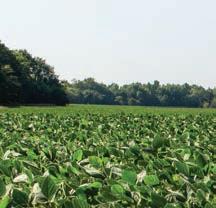




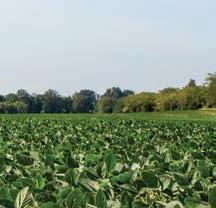



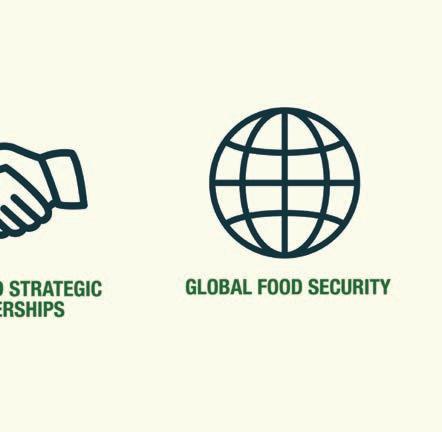

Providingyoungsoybeanfarmersthefoundational knowledgetheyneedtopropeltheirfarmfroma wayoflifetoafull-fledged,growingbusiness.





















Certificateofcompletion awardedattheend.



















Featuring content from The Ohio Soybean Council’s GrowU Program
Put together a marketing plan that will help you capture profitable prices to continue farming year after year. As part of the Ohio Soybean Council’s effort to support young and beginning farmers, the GrowU program provides foundational knowledge around topics like grain merchandising to grow your business. Dwayne Wilson is a grain merchandising specialist with White Commercial Corporation. For the last fifteen years, Dwayne has been helping Ohio producers successfully market their grain.
“We are not out to figure out how to try to hit the highs,” Wilson said. “But to go about a plan that will continue to help you capture profitable prices that help you continue to farm year after year.”

better land, better relationships and more money.”
season,” Wilson notes. During harvest, growers might be trying to harvest and market at the same time, with emotions high, you may settle for a price rather than capturing a higher one. “The importance in that is to keep in mind that you need a plan otherwise you’ll ride that emotional rollercoaster of whether it’s a good price or not and miss some good opportunities that you have in the pre-harvest season.”
One major consideration to take into marketing post-harvest is cost. There will be cost in at least one of three ways — maintaining grain, elevator storage and interest.
Wilson likes to begin by identifying your goal when capturing prices in the market. “When we think about the goal of farm marketing, it’s not about the highest prices.” Think about all the assets that go into a growing season: the equipment, the land, the relationship with landlords and money to name a few. “The goal of farm marketing is to protect that asset, that investment that you have. And we need to market the grain so that at the end of the season, you have
The Chicago Board of Trade gives growers the opportunity to price out the crop over two years prior to
“ e majority of pricing opportunity happens in
season”
— Dwayne Wilson
the harvest. Within that time frame, new information can cause different decisions, that’s why its important to have a plan set in place rather than rely on emotions.
These opportunities to market grain can be broken down into three time periods: pre-harvest, during harvest and post-harvest.
“The majority of pricing opportunity happens in pre-harvest
“There are marketing opportunities where there are some higher prices post-harvest, but most of the time you are working to get back to those earlier levels when you take those costs into account,” Wilson said.
There are three fundamental patterns you need to take into account when talking about these time periods: (1) Look at pricing opportunities in May, June and July, (2) during harvest brings the lowest prices and (3) postharvest is just playing catch up.
“When working with these farmers over the years in these time periods, what I found is a lot of farmers take a price because they have to or they sell because they have to regardless of whether that price is profitable or not. We want to help you by having a plan that locks in profitable prices, so that you sell because its profitable, not because you have to.”
Learn more about creating a grain marketing plan with Dwayne Wilson by visiting SoyOhio.org/GrowU u




By Maggie Good, AgOne Program Director
Agricultural leaders are generous in their service by giving their time and talents to advance the mission of their organizations. Driven by passion, leaders in our industry make a meaningful impact in the boardroom where decisions are being made that affect farms and family businesses like theirs. This impact becomes even more powerful as they are equipped with the tools needed to lead well.
Earlier this year Ohio State’s Leadership Center launched AgOne, a new, year-long program for agricultural industry board members to focus on self-leadership, team leadership, and stewardship to help these leaders leverage that board impact even more. The program, a partnership between The Ohio State University College of Food, Agricultural, and Environmental Sciences, the Department of Agricultural Communication, Education, and Leadership, and the OSU Leadership Center is poised to bring expertise in business, leadership,
and boardmanship to Ohio’s agriculture industry.
Throughout the program, members complete skill and behavior assessments, receive one-on-one coaching sessions, attend in-person and virtual workshops, participate in group discussions, and expand personal networks. Participants go through training on a variety of topics allowing participants to dive into their strengths and weaknesses, learn how to communicate with others, and understand their influence.
AgOne is designed to transform individual influence for industry impact through leadership and boardmanship training. Cohort members serve as board members within the organizations that nominate them and are looking to take the next steps in their leadership journey. Upon graduation, they will earn a Foundational Leadership Certificate from The Ohio State University, develop a leadership plan for their future, and strengthen their network, all aimed at gaining a better understanding of board effectiveness.
First AgOne cohort. From le to right: Maggie Good, OSU Leadership Center; John Linder, Ohio Corn & Wheat Growers Association; Mike Videkovich, Ohio Farm Bureau Federation; Nathan Eckel, Ohio Soybean Council; Chris Weaver, Ohio Farm Bureau Federation; Sandra Lausecker, Ohio Poultry Association; Rose Hartschuh, Ohio Farm Bureau Federation; Dr. Je King, OSU Leadership Center
Nathan Eckel, a row crop and beef producer from Wood County, and Ohio Soybean Council Board member, has been a part of the inaugural cohort of the program. He joins individuals from the boards of the Ohio Farm Bureau Federation, Ohio Corn & Wheat Association, and the Ohio Poultry Association, allowing him to learn how other leaders serve their organizations and manage their operations. When asked what he has gained from the program he said,
“I have never done this much self-reflection before. The AgOne program has given me the opportunity to look at my strengths and weaknesses and think about how I can best lead in the agriculture industry and on our farm. I am learning how to communicate with other leaders by listening effectively. Connecting with others without an agricultural background has allowed me to share my story and connect on similar challenges we all face.”
Eckel will graduate from the AgOne program in December of this year with a leadership plan for how he can continue to be an asset to the agriculture industry, the Ohio Soybean Council, his community and beyond.
The OSU Leadership Center will host two cohorts of AgOne each year beginning in August and January. If you are a board member or an aspiring board member and are interested in participating in the program, visit agone.osu.edu for the application periods and more information. u


Farm succession planning is the process of transferring the ownership and management of a farm business to the next generation of owners. A farm succession plan, also called a farm transition plan, is a key component of any farm’s overall business management plan. A good plan increases the likelihood of passing a viable farming operation to future generations and keeping farm assets within a farm family.
Succession planning begins with identifying goals for the future of both the farm and the family. Frequently, the primary goals of the family are to keep the farmland in the family and prepare the next generation of farm managers. Other goals could include providing for retirement, addressing special issues with children, or planning for long term health care. Whatever the goals may be, healthy family communication and conflict management are often necessary to accomplish this important first step of succession planning.
After developing farm goals, the next step in the farm transition planning process requires the identification of strategies to implement the established goals. Strategies will likely be necessary in several different areas:
Human resource strategies to identify, prepare and train the next generation of the farm business managers.
Financial tools to aid in funding and implementing goals, such as insurance and retirement plans.
Legal strategies and tools for effective asset protection and transfer, such as estate planning and business planning instruments.
Who should drive this farm succession planning process? We often think of succession planning as the responsibility of the older generation to implement for the younger generations.
By Robert Moore, Attorney with the OSU Agricultural & Resource Law Program, and David Marrison, OSU Extension Agriculture & Natural Resources Educator
But succession planning should be addressed for each generation at each stage of their farming careers. It is never too early to start thinking about farm succession planning.
Exploring and understanding the farm’s succession plan is an important part of the learning process for beginning farmers. Farmers who are just beginning their careers are usually focused on learning about managing a farm business and finding their roles within the farming operation. An established
succession plan should align with the beginning generation’s goals and capabilities. If it does not, the younger generation should encourage the older generations to modify the succession plan to meet their needs. If the elders are unable or unwilling to adjust the succession plan, perhaps joining the family farming operation is not the best opportunity for the young farmers. It is better to discover that you do not fit into the family farming operation at 25 years old than at 55 years old.
Some farms may not have a succession plan at all. When that’s the case, the younger farmers should strongly encourage the older generations to develop a succession plan. Most farmers begin their career working long hours for relatively low wages to help the farm grow and are willing to make this sacrifice provided they will someday receive a viable farming operation. Without a succession plan, the younger generation cannot be sure what they are working towards. No farmer wants to find themselves in the situation where they have worked their whole lives on the family farm only to find they cannot continue the farm due to an insufficient or non-existent succession plan. Beginning farmers should stress the importance of a good succession plan to the older generations.
For farmers who are established in their farm careers but not yet looking towards retirement (the “middle generation”), a succession plan is also very important. A succession plan helps transition farm assets from the older generation to the middle generation. The succession plan ensures that assets, specifically land, is either inherited by the middle generation, can be successfully purchased by the middle
generation or are available in some way to the middle generation. Even established middle generation farmers can struggle to continue the farm if the older generation’s succession plan is insufficient.
The middle generation should also implement or update the succession plan for the younger generation. A plan that was implemented when the farm family children were minors will likely be different than the plan needed when the children are young adults. And keep in mind that a good succession plan is necessary to protect the sacrifices that younger generation may be willing to make to join the farming operation.
A succession plan is also important to the oldest generation. This generation no longer needs the succession plan
to address what assets they might inherit but, rather, needs a succession plan to address how their children or grandchildren will inherit farm assets. And of course, the plan must also provide for the oldest generation’s financial needs.
The challenge for many older farmers is balancing the goal of passing a viable farming operation to the next generation while providing an equitable inheritance to non-farming heirs. This challenge can deter the oldest generation from thinking a fair plan is possible. Many financial and legal tools can address this issue of equitable inheritance between farm and non-farm heirs, however. Professionals knowledgeable and creative in farm succession planning can assist the older generation in creating and implementing a plan that is fair for all family members.
The Ohio Soybean Council (OSC) wants Ohio farmers to be on the leading edge of technology, agronomic research and water quality. In a soybean-checkoff-funded project with Ohio Ag Net, Ohio Field Leader is able to do just that.
This summer, Field Leader traveled across Ohio and continued its Roadshow program by talking to farmers about their crops and operations. Following the goal to keep farmers up-to-date on leading practices, sharing what other farmers in Ohio are doing can spark ideas for what to implement on your operation.
So far, Field Leader has visited five operations this summer. Host farmers included Jonah Neill of Washington County, Ohio Soybean Association President Patrick Knouff of Shelby County, OSC Chairman Jeff Magyar of Ashtabula County, OSC Board
Member
John Motter of Hancock County, Les Siler of Fulton County and Pat Hord of Wyandot County. Numerous topics are covered during the Roadshow segments including crop management, pest management, high oleic soybeans and supply chain impacts.
Succession planning is a lifelong process
Farm succession planning can and should be a lifelong process for each generation of the farm family. The succession plan may be important for different reasons to different generations at different times in their careers. But good succession plans are universal in that they can continue the family farm and keep farm assets in the family for generations to come.
Assistance with farm succession planning
Ohio State University Extension offers farm succession planning resources and workshops that can help a farm family develop a farm succession plan. See OSU Extension’s “Planning for the Future of Your Farm” materials and workshops on OSU’s Farm Office website at go.osu.edu/farmplanning u

Farmers listened to presentations from OSC and Airable Research Lab sta at a Feeding Farmers event hosted by Field Leader and OSC in Ashtabula County.
In conjunction with the Roadshow, the guest farmer invited neighboring farmers and industry partners to lunch provided by OSC and Field Leader. While there, farmers listened to a presentation about the soybean checkoff and how OSC is investing for the future of the industry. The lunch offered a steady break from work and plenty of conversation.
To watch all the Roadshow content from this summer and to stay updated on the latest technology and agronomic innovation, visit OCJ.com/Ohio-Field-Leader.



The Ohio Soybean Council (OSC) invests in agronomic research to keep yields high and pests low. Thanks to funding from the soybean checkoff and The SCN Coalition, Ohio growers can send in up to two soil samples to The Ohio State University to be tested for SCN — free of charge!
What is SCN?
Soybean cyst nematode (SCN) is the leading cause of soybean yield loss in North America. It was first identified in Ohio in 1981 and since then it has been found in 72 of the 88 counties. SCN attacks the roots of soybean plants, robbing plants of necessary nutrients and leaving wound sites for root-rotting fungi to enter. This pathogen can cause up to 22 bushel per acre of yield loss.
“One of the main reasons this nematode remains the most economically important pathogen of soybean in North America is that it can cause yield reduction between 15 to 30 percent with absolutely no visible symptoms! In addition, the use of the same source of resistance resulted in a shift in SCN virulence to adapt and parasitize soybean cultivars with SCN-resistance. In other words, nematodes are becoming resistant to the resistance,” said Horacio Lopez-Nicora, Assistant Professor in the Department of Plant Pathology at The Ohio State University.
“Soybean cyst nematode is silently gaining territory in Ohio as SCN numbers are rising. The ability to reproduce on soybean cultivars with ‘SCN-resistance’ will lead to an imminent loss in our battle to protect Ohio soybean production. Managing SCN begins with an adequate and correct soil sample.”
Why should I test?
There can be three to six generations of SCN in a single growing season and each cyst can contain 200 or more eggs. Therefore, SCN egg populations can build up very quickly on a plant in one growing season. These free soil sample tests will tell growers if SCN is present in the fields, the number of SCN per 100 cubic centimeters of soil and the severity of the SCN in your fields. Additionally, Lopez-Nicora and his team will recommend best

management practices moving forward, also free of charge!
“To act, we need to know our SCN numbers. Keeping SCN population densities low and avoiding the rapid increase that could easily reach damaging levels in one growing season is easier than bringing high SCN levels back down to below damage threshold ,” states Lopez-Nicora.
Best time to test
Do you know if SCN is in your fields? If you don’t know, then the best time to test would be anytime, including now! Lopez-Nicora and his team are accepting samples year-round. Preplanting and post-harvest are good
times to sample for SCN because fields are cleared, and you can start management practices to control and prevent SCN growth.
Different sampling strategies can be used to collect soil sample for SCN testing, including those used for soil fertility sampling. Lopez-Nicora’s team strongly recommends using a 1-inch-diameter cylindrical probe to collect between 15 to 20 soil cores, 8 inches deep, for every 20 acres. Collect these soil cores in a zig-zag pattern across an area similar in soil texture and cropping history. Thoroughly mix the composite sample by gently breaking the soil cores. At this point they advise splitting the composite sample in two: one for soil fertility and one for SCN testing. Place 1 pint (approx. 2 cups) of soil in a labeled plastic bag and ship it to the lab as soon as possible. The soil sample collected for SCN testing is alive! Handle it very carefully. To keep the nematodes alive, store the samples in a cool, dark place out of direct exposure to sunlight.
Download and complete the Soil Sample Submission Form to mail with your samples. The form contains the mailing address and any additional information. For additional questions, contact Horacio Lopez-Nicora at lopez-nicora.1@osu.edu .
To learn more about your soybean checkoff’s investment in agronomic research and pest management, visit SoyOhio.org. u
Scan the QR code to watch a video on how to check for SCN in your fields.

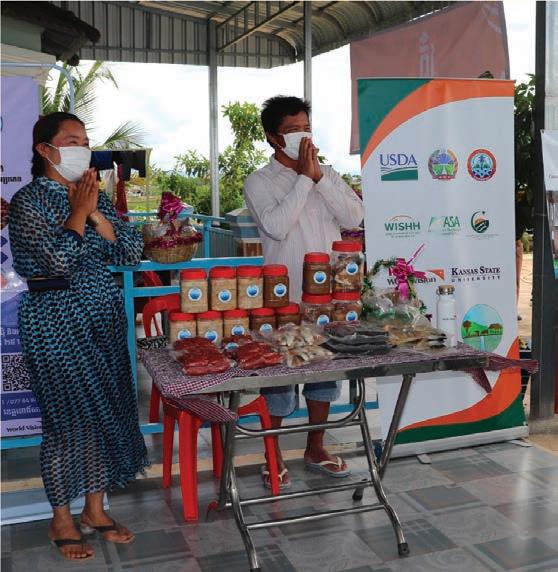












“THE CHECKOFF HAS BEEN A HELP TO US. IT'S OPENED FOREIGN MARKETS AND FUNDED RESEARCH ON DISEASES AND FUNGI. THE RESEARCH AND DEVELOPMENT HAS JUST BEEN VERY POSITIVE.”
-JAN LAYMAN, KENTON, OHIO













BY INVESTING IN THE SOYBEAN CHECKOFF, FARMERS ENSURE END-USER DEMANDS ARE MET WHILE RAISING SOYBEANS PROFITABLY. USING INFORMATION FROM THE OHIO SOYBEAN COUNCIL, FARMERS TRACK RESEARCH ON NEW VARIETIES, NEW USES AND NEW FOREIGN MARKETS TO GROW NEW OPPORTUNITIES.
LEARN MORE AT SOYOHIO.ORG/HEREWEGROW.